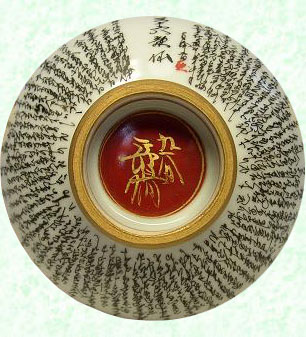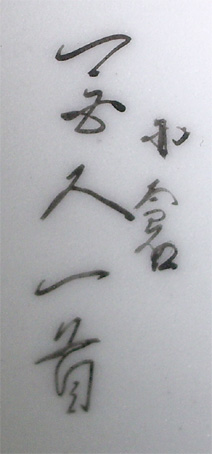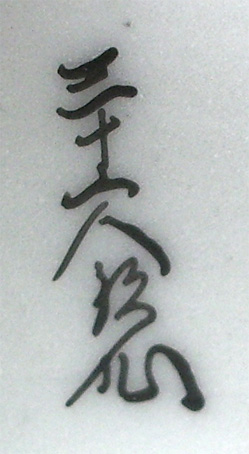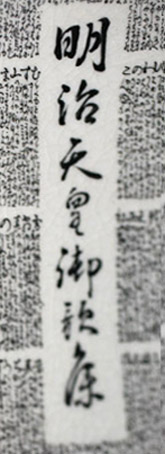Japanese calligraphy
JAPANESE CALLIGRAPHY - 毛筆細字
It is around 1882 that the painters Nomura Zenkichi (野村善吉), (宮荘一藤) and Takahashi Hokuzan (高橋北山) started doing calligraphy in ceramics and wrote very small kanji around and also inside small kutani ceramic objects such as guinomi, sakazuki.
The fashion slowly developed and from 1887 has appeared in Kanazawa a lot of small kutani porcelains, rice bowls, dishes, koro, tea cups produced by famous painters such as Shimizu Bizan (清水清閑), Sasada Yuzan (笹田友山), Takeuchi (竹内誠山), Hachida (八田逸山). In fact they were requesting local calligraphists to write kanji inside and or outside to decorate their production
At the begining calligraphists were using Kanshi (漢詩), which is a Japanese term for Chinese poetry and also using Chinese characters.
Later during Taisho period the fashion moved to Japanese poetry and for example Yakuninisshu (100 poems, 100 poets) or Sanjurokka sen (36 immortals) has been widely used.
In 1895 Oda Seizan (小田清山) and in Terai, Ohara Eizan (大原江山) started calligraphy under the guidance of Nomura Zenkichi. Oda Seizan has improved this technique established few years and became specialized in this field. In 1912 Oda Seizan was mastering the calligraphy and will eventually become the most famous calligraphist and 1953 a Living National Treasure. Only few painters have since succeeded to reach a similar level.

|

|

|
In the data base, Kutani ceramics with calligraphy are classified according to 3 criteria which can be combined:
- name of calligraphist who generally did only inside calligraphy
- name of the painter or potter who did the pot and the painting
- name of the kiln which has produced the ceramic
When the calligraphist is not identified, it is marked unknown.
Regarding the motifs used by the artists, there are either Chinese poems or Japanese traditionnal litterature and mainly Japanese poems called Waka (和歌). Waka is a japanese short poem written with 31 syllabes in five lines of 5, 7, 5, 7, 7 syllabes.
I would say that probably 50% of all Japanese calligraphy refer to 2 most famous poems
小倉百人一首 - Ogura Hyakunin isshu - 100 persons one poem
This is a compilation of the 100 most famous poems written by 100 different poets in a Waka style. This compilation is very famous and every Japanese know about and for the most advanced student know the whole content.
This particular compilation running from the seven to the thirtenth century is said to have been made by a poet called Fujiwara no Sadaie or Teika (1162- 1241) from Ogura district in Kyoto.
This is so famous that there is a game card generally played at new year’s with the 100 poems and players should tell the end of the poem at the view of the first sentences.
For a full text of the poem - Courtesy of Virginia University
Example of titles of the Hyakunin Isshu poem:

|

|

|
三十六歌仙 - Sanju rokkasen - The 36 immortal poets
It is a list of the most famous poets compiled in the Xth century by Fujiwara no Kinto as representative of the period. All these poets were specialist of Waka.These poets are also called the immortals.
Example of titles of the Sanjurokka sen motif:

|

|

|

|

|
明治天皇御製 - Meiji Tenno Gyosei is also a famous poem of the Japanese litterature.
It is a set of 90 000 poems (waka - 和歌) written by the Japanese Emperor Mutsuhito (睦仁) (1852-1912).
Example of title for Meiji Tenno Gyosei motif.

If you wish to have a complete view of the motifs found on Kutani ceramics, please check in the data base calligraphy by motifs. Today there are 27 differents calligraphy motifs recorded. Additional motifs may be added when discovered.
Note: All photos are coming from Kutani pieces recorded in the database







